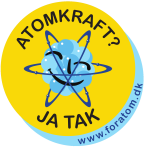Background
The accident happened on 25 March 1979 on a small island called Tremileøen, or Three Mile Island, in a river in Pennsylvania, USA.
It was a pressurized water reactor (PWR) where a safety valve in the primary cooling circuit opened as it should at a slight overpressure but remained open where it should have closed automatically. Therefore, the reactor lost more cooling water than usual. This was misinterpreted by the operators, who believed the valve was closed and, accordingly, inappropriately regulated the cooling water pumps. During this process, the water level in the reactor dropped so much that the upper part of the fuel was not cooled. Therefore, it partially melted and fell into the reactor, which was destroyed and never restarted.
It was rated “INES 5” on the international incident scale. See under INES.
Radiation dose

The approximately 2,000,000 Tremilleøen received a radiation dose of approx. 0.01 mSv. This corresponds to 1/8 of the dose you get by flying across the Atlantic to North America or the same dose as two X-rays at the dentist gives [1, 2]. The global average background radiation is 2.4 mSv per year [3].
Health effects
The accident’s exposure had no detectable health effects on the factory workers or the surrounding public. No deaths or illnesses as a result of radiation.
At Three Mile Island, the investigation into the accident, initiated by then-President Carter, concluded that the greatest health consequence was the stress on the area’s residents [4].
Environmental impacts
Is was no damage to the surrounding environment or river because the reactor containment building contained the extreme majority of radioactive materials.
The U.S. Nuclear Regulatory Commission, Environmental Protection Agency, and other governmental and independent groups conducted detailed studies. They concluded that the accident would not have any significant environmental impact [5].
The lesson of Tremileøen
Containment buildings work. Unlike Chernobyl, Tremileøen, like all other nuclear power plants worldwide, had a containment building. Despite melting the reactor core, the reactor vessel contained the damaged fuel.
Clear communication with the public is essential. The confused communication during and after the accident contributed to unnecessary panic and public fear, which was the most dangerous part of the accident.
Experience matters. The type of reactor used at Three Mile Island had grown progressively larger and more complicated over many years. Safety comes in part from deep experience at similar facilities around the world. This experience was relatively thin in 1979 but has increased enormously since then.
Sources:
- https://www.nrc.gov/reading-rm/doc-collections/fact-sheets/3mile-isle.html?fbclid=IwAR2QGbBTAdF2SyM6MkgNu3V2HBcrQj_i4s2uNwGOjcSEbnKe2QVDRPuZj-Q
- https://www.gov.uk/government/publications/ionising-radiation-dose-comparisons/ionising-radiation-dose-comparisons?fbclid=IwAR37dINjM6-COJc-2ZDSYYskKdGEbSgxHffx7Yp7AXB-kJf6AY8E4aNXa2U
- https://www.iaea.org/Publications/Factsheets/English/radlife
- John G. Kemeny et al. “Report of the President’s Commission on the Accident at Three Mile Island.” October 1979. https://inis.iaea.org/collection/NCLCollectionStore/_Public/34/007/34007188.pdf?r=1&r=1
- https://www.nrc.gov/reading-rm/doc-collections/fact-sheets/3mile-isle.html




